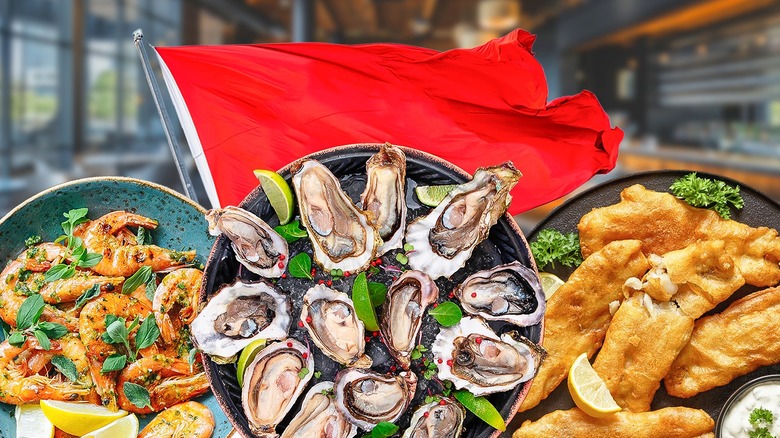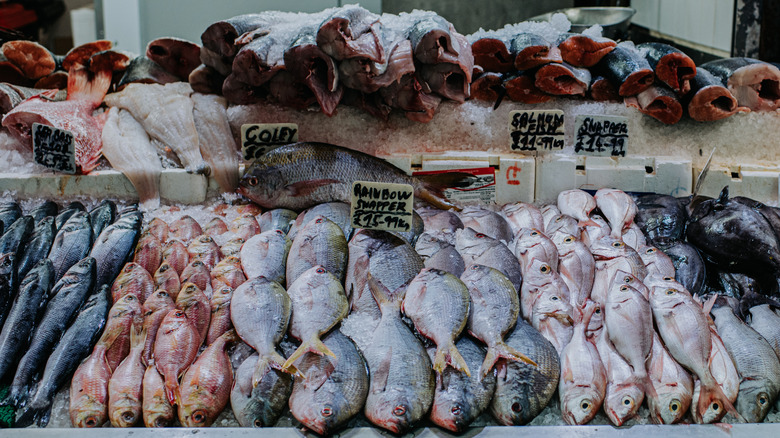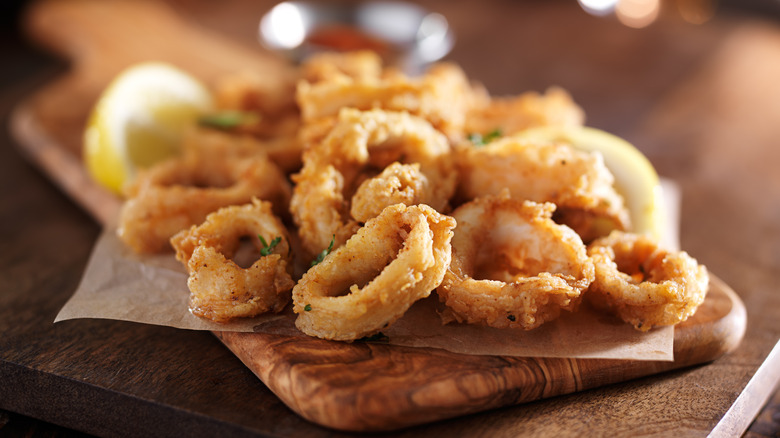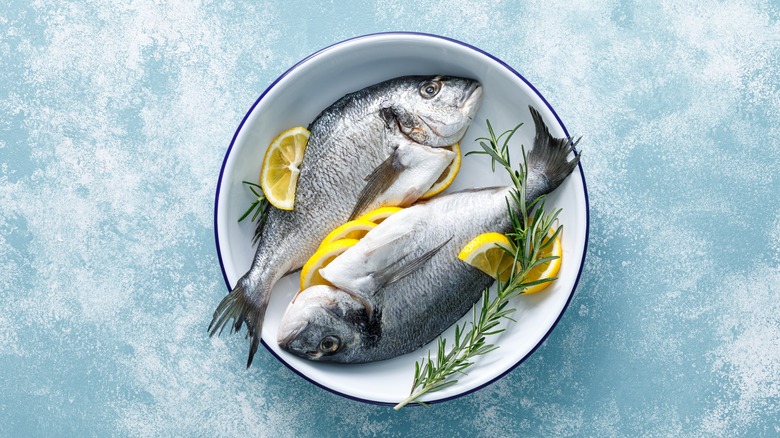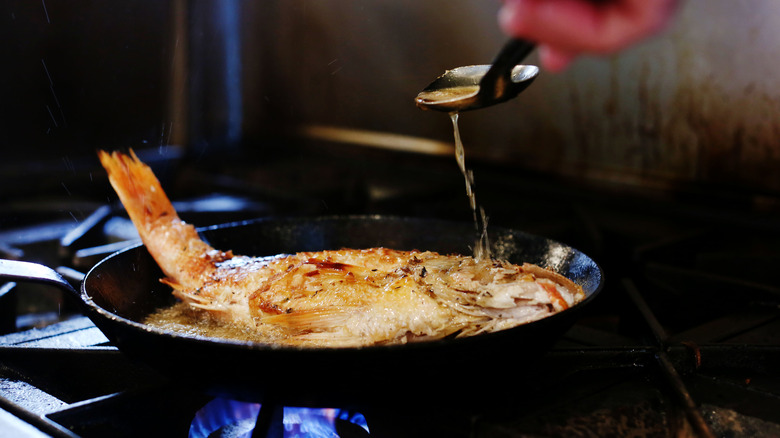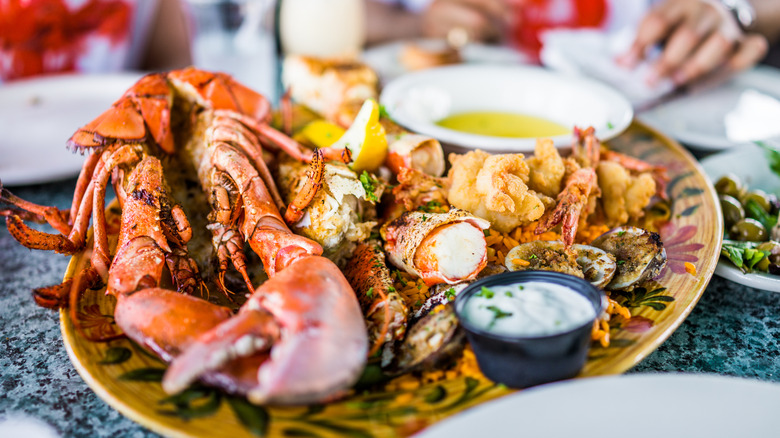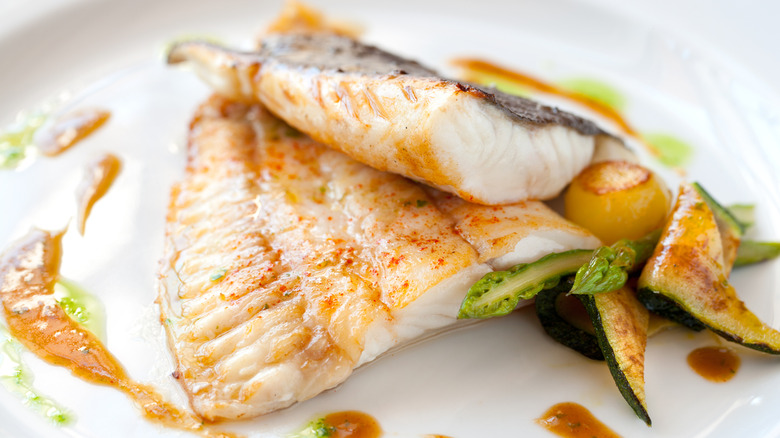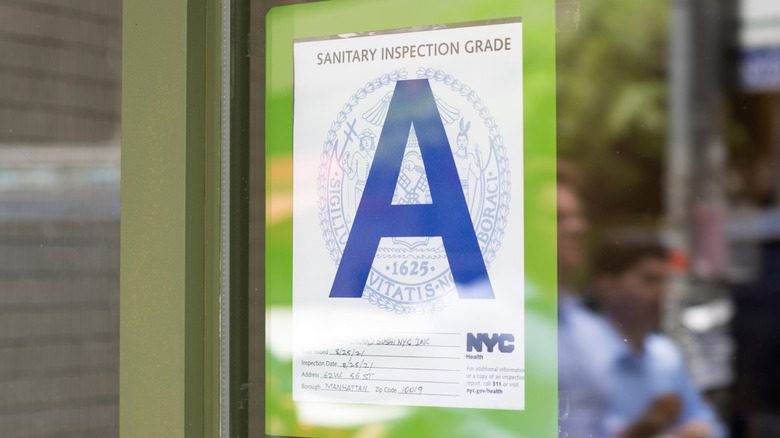Never Ignore These Red Flags At A Seafood Restaurant
Seafood lovers: take note. While the promise of succulent shrimp, briny oysters, and vibrant tuna can be incredibly enticing, it's important to stay mindful of a few key details to ensure you're getting the best experience possible. Seafood is highly perishable, so knowing what to look for can help you avoid any missteps affecting your meal.
To help navigate the waters of seafood dining, we've consulted two experts in the field. Aidan Owens, executive chef at San Diego's Herb & Sea, and Alexander Diestra, executive chef at King Tide in Portland, Oregon, bring years of experience and a wealth of knowledge to the table when it comes to seafood restaurants. These culinary professionals have honed their seafood preparation and dining skills and are here to share their insights.
From mistakes made while buying seafood to strange smells to suspicious menu choices, we'll explore the key warning signs you should never overlook when dining at a seafood restaurant. By the end of this article, you'll be well-equipped to identify potential issues and make informed decisions about where to enjoy your next seafood meal.
The menu doesn't say where it gets its seafood
When looking over a seafood menu, excited about the prospect of a delicious salmon fillet or a flavorful shrimp scampi, it's important to consider where these delicacies are coming from. If the menu is vague about its seafood sources, this could mean that something is awry. Chef Alexander Diestra emphasizes the importance of transparency in sourcing. He advises, "The first thing that diners can do to become aware of this is to look at the menu to see if they are outlining any local purveyors." If there's nothing telling on the menu, he suggests you directly "ask the server where the seafood is being sourced." A reputable restaurant should be proud of its sourcing practices and willing to share that information with customers.
Chef Aidan Owens reinforces this point: "Sourcing locally with fresh ingredients that are treated well by fishermen who care for the fish and the environment will always deliver the best product." If the restaurant seems reluctant to disclose its sources, or if the server appears uninformed when you inquire, it could indicate that the establishment isn't following ideal sourcing practices. In that case, it might be best to take your business elsewhere.
The seafood doesn't smell or taste right
The aroma and flavor of seafood are crucial indicators of its quality and freshness. If your seafood dish arrives with an unpleasant or overly strong odor, it's a cause for concern. Chef Alexander Diestra notes, "Seafood should smell like the sea — a stronger odor is always questionable." Chef Aidan Owens provides further guidance: "If the fish has a smell that is anything except ocean or clean fish, it has most likely been stored improperly." He adds that only a few fatty fish like swordfish, mackerel, and cooked tuna belly will have a more pronounced smell, but leaner fish should not. So, if your mild white fish has a strong odor, it's likely not at its best.
The same principle applies to taste. If your seafood has an overpowering fishy flavor, it might indicate poor storage practices. Owens explains, "When fish is stored in a bag after being cut, they are exposed to water and sit in their own juices. This creates the 'fishy flavor' lots of people don't like." Properly handled fish should have a clean, fresh taste that reflects its oceanic origin — but there are ingenious ways to disguise a fishy taste. In the end, you just have to trust your senses. If something smells or tastes off, it most likely is, which means you probably should take it as a sign to steer clear of that seafood restaurant from now on.
Limited seasonal changes to the menu
Regardless of the season, a seafood menu that remains static throughout the year can be a potential red flag. Seasonal variation in seafood offerings is not just about variety — it's often an indicator of freshness and quality. Chef Diestra points out that limited seasonal changes to a menu can suggest a reliance on frozen seafood. While he notes that "using frozen seafood is not always bad," most seafood, especially shellfish like clams and oysters, is far better when you know the best season to buy them.
Chef Owens's culinary philosophy values seasonal cooking: "I believe cooking with the seasons shows skill. To cook with the products that you are limited to during the seasons and creating something delicious is a challenge." A restaurant that embraces seasonal changes will likely offer a more authentic, fresh, and dynamic dining experience. Without seasonal offerings, diners miss out on the unique flavors that come from seafood at its peak. It can also indicate a lack of creativity or commitment to quality, as the best dishes often come from working with the natural bounty of each season.
Suspiciously low prices
While value for money is always appreciated, when it comes to seafood, prices that seem too good to be true often are. Chef Alexander Diestra warns that unusually inexpensive seafood dishes could easily indicate the use of lower-quality or frozen products. While some of the fanciest fish at restaurants are actually frozen, Diestra points out that certain types, especially shellfish, can lose their prime qualities when frozen. He also emphasizes, "There is no seafood out there of quality that will be cheap," a statement particularly relevant given the rising seafood prices in recent years.
To navigate this at seafood restaurants, it's helpful to familiarize yourself with current market prices for various seafood items. If you come across a menu full of seafood dishes with suspiciously low price tags, it's worth questioning why. In the end, paying a little more for properly sourced seafood tends to be a much safer — and tastier — bet.
All of the seafood on the menu is fried
A seafood menu dominated by fried options can be a potential cause for concern. On this topic, Chef Diestra offers some valuable insight: "If all the seafood is fried and battered, then [the restaurant] is probably hiding something." While there's certainly a place for well-prepared fried seafood dishes, an overreliance on this cooking method is just not a great sign, as this cooking technique can sometimes be used to mask the taste and texture of less-than-fresh fish or lower-grade seafood.
However, it's important to note that the presence of fried options doesn't automatically signal poor quality. The key is balance and variety in the menu offerings. A reputable seafood restaurant should provide a range of preparation methods that showcase the natural flavors and textures of their seafood. Look for menus that feature grilled, baked, or raw options alongside their fried selections of things like calamari or fish and chips. A diverse menu showcases a chef's confidence in the quality of their ingredients and their impeccable culinary skills.
Out-of-season seafood is being sold at a high price
Paying premium prices should guarantee top-quality ingredients, but is that always the case? No, it's not. Spotting out-of-season seafood on a menu at high prices should raise a red flag for savvy diners. As Alexander Diestra points out, this practice can often signal questionable pricing strategies. He warns that some restaurants may be using this tactic to mask lower-quality seafood, taking advantage of customers who may not be familiar with seasonal availability or current market prices.
Offering a broader perspective, Aidan Owens explains that much depends on whether the seafood comes from local purveyors or mass-produced farms. He advises, "Look for local seafood. Although it may cost a little more, the benefits of it are astronomical, not just to the diner but to the environment they live in."
Meanwhile, the source of out-of-season seafood is generally either unsustainable farms or processed and frozen imports, both of which compromise quality. That's because these options lack the freshness of locally sourced seafood and often involve questionable environmental practices. Diners paying premium prices for such seafood essentially pay for convenience, not quality. For these reasons, it's a good idea to question it when a restaurant charges top dollar for seafood that is not in season.
There's excessive sauce on the all seafood
While a well-crafted sauce can certainly enhance a seafood dish, an excessive amount of sauce across a range of the menu's seafood offerings is not what you want to see. This approach to preparation may sometimes be used to conceal issues with the quality or freshness of the seafood. Chef Diestra provides a straightforward assessment: "If the fish is covered by a lot of things, they are trying to hide either low quality ingredients or mishandled food." Diestra advocates for simplicity in seafood preparation, stating, "The simpler, the better to let the protein shine on its own."
Chef Owens agrees. "Personally, I've always found simple is best with seafood. Simple sauces, simple vegetables," he says. His general seafood preparation guidelines include things like "woodfire, lemon, butter, capers, the list goes on. As long as they are in balance and the fish is properly treated and prepared, the dish will always be a home run." The takeaway? If your seafood arrives drowning in sauce, it's a red flag. High-quality, fresh seafood should shine with minimal, balanced seasoning, allowing its natural flavors to take center stage.
The seafood isn't sustainably sourced
In today's environmentally conscious culinary landscape, sustainable seafood sourcing is not just a trend but a crucial factor in both the quality of your meal and the health of our oceans. While it may require some inquiry, understanding a restaurant's sourcing practices can help ensure you're supporting responsible fishing methods and enjoying fresh and ethically harvested seafood. Chef Diestra encourages diners to be proactive in finding out from where the fish is being sourced. "From there, I would be aware [of whether] they were practicing good sourcing policies with local and sustainable approaches." He notes that unsustainably sourced seafood can impact its "flavor profile and texture," demonstrating that sustainable practices often correlate with higher quality so it's important to know the difference between wild and farmed fish.
Chef Owens elaborates on the importance of seasonal, sustainable sourcing: "When we use what the environment is producing, we are in effect not disrupting the natural reproduction patterns of the animals in our environment." He also points out that this approach usually implies a restaurant's connection to local fishermen and farmers, showcasing a commitment to community and quality. So, when dining out, it makes sense to find out the origin of the seafood and the restaurant's overall sourcing practices.
Portion sizes are too big
Generous portion sizes can feel like a win at first, but when it comes to seafood, an overly large serving might actually signal a problem. Rather than a treat, it could be a red flag about freshness or quality — especially when seafood prices are climbing. According to Chef Diestra, "A well-portioned dish to appeal to clientele perception of value is good." But when the portion is enormous for a suspiciously low price, it might indicate that corners are being cut.
That's not to say that all big portions are a bad sign. The trick lies in balance. A well-thought-out seafood dish should feature just enough protein to shine while the sides and sauces work in harmony. If you're staring down at a seafood plate that seems excessive for what you're paying, consider why that might be. With seafood, quality should always take precedence over quantity, and a restaurant dishing out massive portions might be prioritizing perception over flavor and freshness.
Seafood texture is overly soft
The texture of seafood is a key indicator of its freshness and quality, and unusually soft or mushy texture often signals improper handling or storage. Chef Aiden Owens provides a clear warning when he says, "If the filet has a mushy texture, that means the fish has not been treated well. Most likely frozen and unfrozen." Owens acknowledges that freezing can benefit certain types of seafood, pointing out that flash-freezing can be effective for preservation in some cases. However, he cautions that freezing can easily result in an undesirably soft texture for most fish.
Chef Diestra elaborates on the ideal texture of the fish you're about to eat. "The texture of fresh fish is firm and moist, while frozen fish can change in flavor or appearance if handled incorrectly," he explains. This underscores the importance of proper freezing and storage mistakes that could be ruining food. For this reason, it's important to pay close attention to the texture of your seafood when dining out.
Health department grade is subpar
The health department grade of a restaurant is a critical indicator of its adherence to food safety standards. A low health grade is very bad news for seafood restaurants, where proper handling and storage are even more crucial. In fact, any grade lower than an A- from the Official Health Department should prompt careful consideration before dining. "Restaurants go through health inspections and should be following those health standards by keeping records of shellfish tags and logging temps," emphasizes Chef Alexander Diestra. He further explains the delicate nature of seafood handling: "It's easy to mishandle shellfish — from the way it's cleaned and monitored to its lifespan being much shorter than other seafood. They need to be fresh and maintained at a certain temperature to be served appropriately."
Unfortunately, a low health grade likely shows that the restaurant's food handling practices are not up to standard. According to Chef Aiden Owens, "If fish is not stored properly, there can be serious consequences. Health impacts and sickness. There are often parasites in fish; if proper precautions are not taken, they can be passed on to the diner." So, before stepping foot into a seafood restaurant, it's advisable to check its current health department grade. This simple step can help ensure a safer and far more enjoyable dining experience.
The color of the fish is off
The appearance of seafood is one of the first clues to its quality, and if the color looks off, something has likely gone wrong behind the scenes. Whether due to poor handling or inadequate storage, discolored seafood can mean it's not fresh or perhaps not even safe to eat. Chef Alexander Diestra says if the fish is a pale pink, that's a red flag. Fresh seafood should have vibrant, rich tones. Take salmon, for example — its flesh should be a bold, bright orange, not washed out or dull.
At a top-notch seafood restaurant, presentation and quality go hand-in-hand. Seafood should look as enticing as it tastes, with natural, radiant colors that showcase its freshness. If what's on your plate appears dull or unappealing, chances are the taste won't be much better. So, trust your instincts, eyes, and nose when dining out. If something seems off, it might be best to dine elsewhere.
